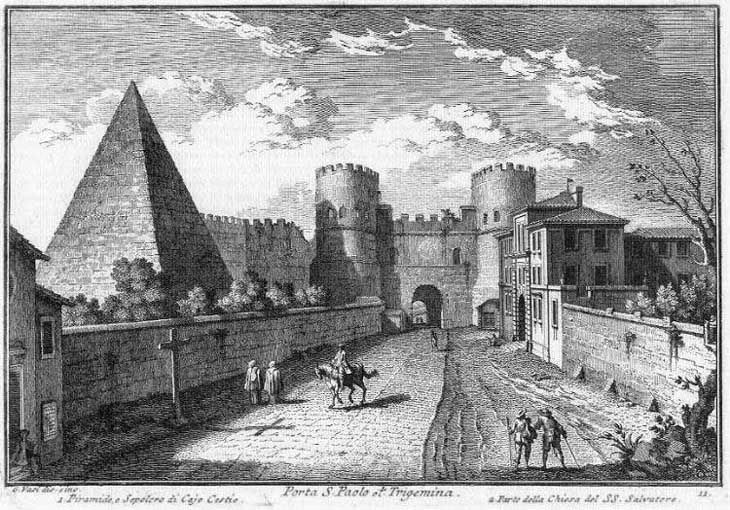Although we associate pyramids with Ancient Egypt, these four-sided structures with a tapering top are found all over the world, built by many different cultures, such as the ancient Kushite rulers of Nubia and the Andean cultures of South America. The Romans also built pyramids, and one of the best examples is located in Rome itself.
The Pyramid of Cestius was built for Gaius Cestius Epulo, a politician, praetor and priest, whose wish was to be buried in a tomb built in the style of the Egyptians. And so it was.
Photo: Dennis Jarvis/Flickr
The pyramid was built sometime around 18 to 12 BC and was completed, also according to Cestius’s wish, in 330 days. The pyramid stood 125 Roman feet high (about 37 meters) and measured 100 Roman feet (about 29.6 meters) square at the base. It is covered by slabs of Lunense marble. At the time of its construction, the Pyramid of Cestius would have stood in open countryside as tombs were forbidden within the city walls. Rome grew enormously during the imperial period, and, by the 3rd century AD, the pyramid would have been surrounded by buildings. It originally stood in a low-walled enclosure, flanked by statues, columns and other tombs. Some of these were recovered during excavations in the 1660s.
Inside the pyramid is a burial chamber, a simple barrel-vaulted rectangular cavity measuring 6 meters long, 4 meters wide and 5 meters high. The walls are decorated with frescoes of nymphs and winged Victories holding a crown and ribbon in their hands. The tomb had been sealed when it was built, but was plundered probably in the Middle Ages through a tunnel dug on the northern side, which resulted in the loss of the cinerary urn and significant portions of the decoration.
An 18th century sketch of the Pyramid of Cestius by Giuseppe Vasi (1710–1782)
The pyramid was built during a period when Rome was going through a fad for all things Egyptian. The Circus Maximus was adorned by Augustus with an Egyptian obelisk, and pyramids were built elsewhere in the Roman Empire around this time. The Meta Romuli is one that stood by the Tiber for 1,500 years before it was demolished in the 16th century. However, contrary to the popular belief, the design of the pyramid was not based on the pyramids of Egypt. The sharp angles of the sides, rising into a severe point at the top is strongly reminiscent of the pyramids of Nubia, in particular of the kingdom of Meroë, which had been attacked by Rome in 23 BC. It’s possible that Cestius had served in the military campaign against the Nubian kingdom and was inspired by the pyramids he saw there.
At the time the pyramid was constructed, there were sumptuary laws which regulated how one displayed their wealth through clothing, feasts, funerals and tombs. Because Cestius’s tomb was fabulous, it was banished from within the city walls. The pyramid was incorporated into the walls during the construction of the Aurelian Walls between 271 and 275 CE to form a triangular bastion. It was one of many structures in the city to be reused to form part of the new walls, probably to reduce the cost and enable the structure to be built more quickly. It still forms part of a well-preserved stretch of the walls, a short distance from the Porta San Paolo.
Photo: Roger Ulrich/Flickr
By the Middle Ages the origin of the pyramid was forgotten. Petrarch records that inhabitants of Rome believed that it was the tomb of Remus (Meta Remi) and that its counterpart near the Vatican was the tomb of Romulus. Its true provenance was clarified only after excavations in the 1660s, which cleared the vegetation that had overgrown the pyramid and uncovered the inscriptions on its faces. They also tunneled into the tomb's burial chamber and found the bases of two bronze statues that had stood alongside the pyramid.
The pyramid was an essential sight for many who undertook the Grand Tour in the 18th and 19th centuries. Percy Bysshe Shelley described it as "one keen pyramid with wedge sublime" in Adonaïs, and poet Thomas Hardy saw the pyramid in 1887 and wrote a poem, Rome: At the Pyramid of Cestius near the Graves of Shelley and Keats, in which he wondered: “Who, then was Cestius, / and what is he to me?”















They made a parking lot out of it.
ReplyDelete